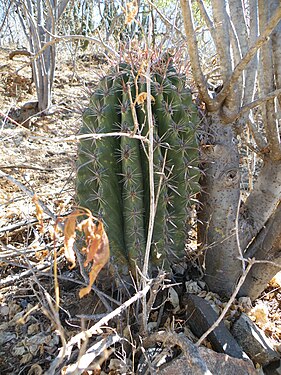Ferocactus townsendianus
| Ferocactus townsendianus | |
|---|---|

| |
| Ferocactus townsendianus in habitat | |
| Scientific classification | |
| Kingdom: | Plantae |
| Clade: | Tracheophytes |
| Clade: | Angiosperms |
| Clade: | Eudicots |
| Order: | Caryophyllales |
| Family: | Cactaceae |
| Subfamily: | Cactoideae |
| Genus: | Ferocactus |
| Species: | F. townsendianus
|
| Binomial name | |
| Ferocactus townsendianus Britton & Rose 1922
| |
| Synonyms[1] | |
| |
Ferocactus townsendianus, commonly known as the Townsend barrel cactus, is a species of cactus endemic to southern Baja California Sur in Mexico. It is a barrel cactus that grows solitary stems up to 1 metre (3.3 ft) tall, with gray to brown spines, with one central spine on each areole usually curved or hooked at the tip, and orange to red flowers that bloom from May to August. Ferocactus townsendianus is similar to both Ferocactus peninsulae and Ferocactus santa-maria, and is sometimes placed under peninsulae as a variety or subspecies.
Description[edit]
Ferocactus townsendianus is a solitary-stemmed barrel cactus with short-cylindric to slightly conical stems, usually to 50 cm (20 in) tall but sometimes to 1 m (3.3 ft). It has up to 16 ribs, often spiraled or somewhat undulate. The areoles are large and distant, with gray to brown spines. There are up to 16 radial spines, slender and widely spreading, and up to 4 cm (1.6 in) long. There are 3 to 4 central spines, with the principal spine typically curved or hooked at the apex (but sometimes straight) and the others straight. The central spines have an annulate texture.[2][3][4]
The flowers appear from May to August, and are orange to red, measuring 5–6 cm (2.0–2.4 in) long. The outer perianth segments are shaped ovate and have a reddish color with yellow on the margins, while the inner perianth segments are shaped oblong-lanceolate and have a narrow pink stripe down the center with yellow margins. The filaments and style are dark pink. The almost globular fruit is 2.5 cm (0.98 in) long and yellow.[2][3][5]
-
Ferocactus townsendianus in flower, with some fruits also visible
-
Flower closeup
-
Fruits
-
Plant growing in the Jardin de Cactus in Guatiza on Lanzarote, The Canary Islands, Spain
-
Adult plant
Taxonomy[edit]
Ferocactus townsendianus was described by Nathaniel Lord Britton and Joseph Nelson Rose in their third volume of The Cactaceae in 1922. The type specimen was collected on Isla San José by Rose in March 1911 while visiting the Gulf of California on the USS Albatross.[2] The specific epithet is named in honor of Charles H. Townsend, the director of the New York Aquarium, who was in charge of the scientific work of the Albatross when the ship was in the waters of the Baja California Peninsula, when Rose discovered the plant.[2]
Distribution and habitat[edit]
Ferocactus townsendianus is endemic to the state of Baja California Sur in Mexico. It ranges from the vicinity of Loreto and San Juanico to the southern Sierra de la Giganta and south into the Cape region. It is also present on Isla San José in the Gulf of California, and Isla Santa Margarita and Isla Magdalena in the Magdalena Bay on the Pacific coast.[1][3]
-
Plant growing in El Triunfo, Baja California Sur
-
Plant growing near La Paz, Baja California Sur
References[edit]
- ^ a b Rebman, Jon P.; Gibson, Judy; Rich, Karen (15 November 2016). "ANNOTATED CHECKLIST OF THE VASCULAR PLANTS OF BAJA CALIFORNIA, MEXICO" (PDF). Proceedings of the San Diego Society of Natural History. 45. San Diego Natural History Museum: 105 – via San Diego Plant Atlas & San Diego Natural History Museum.
- ^ a b c d Britton, Nathaniel Lord; Rose, Joseph Nelson; Eaton, Mary E.; Wood, Helen Adelaide (1919–1923). "The Cactaceae : descriptions and illustrations of plants of the cactus family". The Cactaceae: descriptions and illustrations of plants of the cactus family. 3. Washington: Carnegie Institution of Washington: 127. doi:10.5962/bhl.title.46288 – via Biodiversity Heritage Library.
- ^ a b c Rebman, Jon P.; Roberts, Norman C. (2012). Baja California Plant Field Guide. San Diego: Sunbelt Publications. p. 187. ISBN 978-0-916251-18-5.
- ^ Hunt, David; Taylor, Nigel; Charles, Graham, eds. (2006). The New Cactus Lexicon. Milborne Port, UK: dh Books. p. 122. ISBN 9780953813490.
- ^ Pilbeam, John; Bowdery, Derek (2005). Ferocactus (1. ed.). Oxford: British Cactus and Succulent Soc. pp. 82–83. ISBN 978-0902099760.
External links[edit]
 Media related to Ferocactus townsendianus at Wikimedia Commons
Media related to Ferocactus townsendianus at Wikimedia Commons Data related to Ferocactus townsendianus at Wikispecies
Data related to Ferocactus townsendianus at Wikispecies







